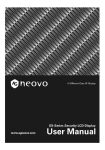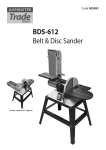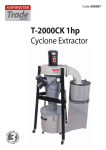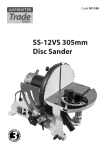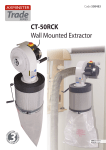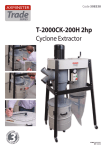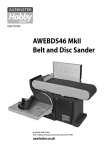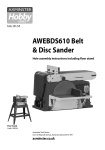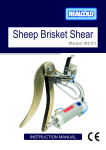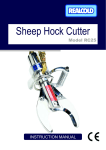Download Axminster BDS-612 Instruction manual
Transcript
Code 501257 AS408 Belt & Disc Sander Axminster Tool Centre, Unit 10 Weycroft Avenue, Axminster, Devon EX13 5PH axminster.co.uk Index of Contents Page No Index of Contents 02 Declaration of Conformity 02 What’s in the Box 03-04-05 General Instructions for 230V Machines 06 Specific to Sanding Machines 07-08 Specification08 Assembly09-10-11-12-13-14-15-16 Assembly Configurations 17-18 Illustration and Parts Description 18-19-20 Sanding Configurations 21 Changing the Sanding Belt 22 Changing the Sanding Disc 23 Maintenance23 Troubleshooting24 Wiring Diagram 24 Parts Breakdown 25 Parts List 26-27 Declaration of Conformity Copied from CE Certificate The undersigned, George N. Sifonios authorised by Meta International Co., Ltd No. 38-46, Ya Ya Hsiang, Taichung Hsien, Taiwan, R.O.C. declares that this product manufactured by Meta International Co. is in compliance with the following standards or standardisation documents in accordance with Council Directives Low Voltage Directive 2006/95/EC EN ISO 12100-1:2003 EN ISO 12100-2:2003 EN 60204-1:2006 Model number (Sander) BDS-46, BDS-48Q, WD-12, WD-20, BS-648, BDS-612, ES-689M, ES-6108, ES-689, ES-9138, CT-1560SM, CT-2060SM, CT-2580SM, CT-1500B, BDS-615 symbols below advise that you follow the correct Warning The safety procedures when using this machine. Fully read manual and safety instructions before use 02 Ear protection should be worn Eye protection should be worn Dust mask should be worn HAZARD Motor gets hot What’s in the Box Model Number: BDS-48Q Box 1 off: Belt and Disc Sander A 1 off: Mitre Fence B 1 off: Dust Extraction Moulding C 1 off: Table Support Steel Rod D 1 off: Table (Adjustable) E 1 off: Pastic Disc Guard Moulding F 1 off: 200mm Cast iron Disc Plate G 1 off: Workstop Plate H 1 off: Sanding Belt I 1 off: 200mm Sanding Disc J 4 off: Rubber Feet with 5/16” Thread K 4 off: 5/16” Nuts K 1 off: M5 x 50mm Phillip Screws L 2 off: M5 x 8mm Phillip Screws L Bag 1 Bag 2 A 03 What’s in the Box B C E 04 D What’s in the Box G J H I F K K L Having opened the box, remove all the components stowed in the packaging. Place these carefully to one side. Remove the top packaging and lift the machine out of the box and place upon a clear flat surface, taking care not to trap or pinch the power cable under the chassis. Remove any other items from the box. Having unpacked your sander and its various components, if you do not wish to retain the packaging please dispose of it responsibly, especially any polystyrene; most of the rest of the packaging is biodegradable. ! NOTE: Please read the Instruction Manual prior to using your new machine; as well as the operating procedures for your new machine, there are numerous hints and tips to help you to use the machine safely and to maintain its efficiency and prolong its life. Keep this Instruction Manual readily accessible for any others who may also be required to use the machine. 05 General Instructions for 230V Machines Good Working Practices/Safety The following suggestions will enable you to observe good working practices, keep yourself and fellow workers safe and maintain your tools and equipment in good working order. ! WARNING!! KEEP TOOLS AND EQUIPMENT OUT OF THE REACH OF YOUNG CHILDREN Mains Powered Tools (General) /Disc and Belt Sander Primary Precautions These machines are supplied with a moulded 13 Amp. Plug and 3 core power cable. Before using the tool inspect the cable and the plug to make sure that neither are damaged. If any damage is visible have the tool inspected/repaired by a suitably qualified person. If it is necessary to replace the plug, it is preferable to use an ‘unbreakable’ type that will resist damage on site. Only use a 13 Amp plug, make sure the cable clamp is tightened securely. Fuse at 13 Amp. It is also good practice to use switched outlets. If extension leads are to be used, carry out the same safety checks on them, and ensure that they are correctly rated to safely supply the current that is required for your machine. This machine is intended primarily for inside/workshop usage. Work Place/Environment Always mount the machine on a flat, level stable surface. There are several methods of achieving this, bolting the machine directly to a ‘good solid workbench’, bolting the machine to a sturdy base board that can be clamped to the ‘good solid workbench’; create an independent entity by bolting the machine to its own stand. However you mount your machine, make sure it is fastened down and stable before use. Paper belts and discs do not respond well to wet or damp conditions. In the worst case the adhesives holding the belt and the abrasive fail completely, the belts fall apart and the abrasive becomes a soggy mess against the edge of your work piece. Try to keep the machine in a reasonably dry, warm environment. If this is not possible; or if the machine is to remain unused for some time, at least remove the belt, put in a ‘plastic’ bag and store in a warm dry place. I’m afraid I can offer no suggestions for the disc, unless you have upgraded to some form of ‘velcro’. fastening method, in which case, do the same as with the belt. (P.S. don’t forget… don’t leave the spare belts/discs in the damp either). Keep the work area as uncluttered as is practical, this includes personnel as well as material. ! 06 WARNING!! Under no circumstances should CHILDREN be allowed in work areas Specific to Sanding Machines ! Warning! The sanding disc cannot be declutched from the belt and vice versa, both functions are active when the machine is running. Remember this, and do not leave loose objects of any description, on the machine if it is going to be used. Once the sander is mounted, carry out any setting operations, (mitre, tilt..), and remove all tools used in the setting operations (if any) and place safely out of the way. If you are working long lengths of material arrange for extra support beyond the boundary of the machine, and check you have sufficient room to manoeuvre the material through all the operations you will wish to carry out. It is good practice to leave the machine unplugged until work is about to commence, also make sure to unplug the machine when it is not in use. Always disconnect by pulling on the plug body and not the cable. After fitting a new sanding disc, it is good practice to lightly sand across the left side of the disc with a reasonable sized (20mm x 50mm) piece of timber to make sure the sanding disc is correctly ‘seated’ on the disc. The sanding action will press the sanding disc firmly back against the disc itself. It is not good practice to wear gloves whilst sanding as one tends to lose the ‘feel’ of the workpiece/sander contact, but obviously this removes the safety barrier between your fingers and the sanding surface. Remain focused and exercise caution whilst sanding. DO NOT sand very small pieces of work with bare hands; try to construct some form of holder. Make sure you are comfortable before you start work, balanced, not reaching etc. If the work you are carrying out is liable to generate excessive grit or dust or chips, wear the appropriate safety clothing, goggles, masks etc., If the work operation appears to be excessively noisy, wear ear-defenders. If you wear your hair in a long style, wearing a cap, safety helmet, hairnet, even a sweatband, will minimise the possibility of your hair being caught up in the rotating parts of the machine, likewise, consideration should be given to the removal of rings and wristwatches, if these are liable to be a ‘snag’ hazard. Do not work with cutting/abrasive tools of any description if you are tired, your attention is wandering or you are being subjected to distraction. A deep graze, a lost fingertip or worse, is not worth it! Do not use the machine within the designated safety areas of flammable liquid stores or in areas where there may be volatile gases. There are very expensive, very specialised machines for working in these areas, THIS IS NOT ONE OF THEM. Check that sanding surfaces are still sufficiently abrasive to carry out the work you intend. Sanding belt cleaning sticks are an efficient method of prolonging the life of the belts and discs, and will also maintain their operating performance. 07 Specific to Sanding Machines Check that the belts or discs are undamaged; torn edges can pick up on the workpiece and will cause the medium to tear, often very rapidly with accompanying sharp flapping edges. Always offer the workpiece to the belt/disc so that the motion carries the work against the restraining surface, (i.e. the work stop or the table, (use the left hand side of the disc). Do not press too heavily against the sanding surface, all this will do is slow the sander down. Remember, sanders work by removing small particles of material quickly and heavy pressure works adversely to the cutting process, further, it will accelerate the rate of ‘clogging’ of the abrasive surfaces, rendering the machine less efficient. If you are attempting to sand inside curves (over the ‘tracking drum’) do not press at all, other than to keep the workpiece in contact with the surface, any pressure could upset the tracking geometry. As there is no cushioning effect to the belt passing around the drum, expect an added vibration and compensate for it. Sanding of certain types of timber may make the fitting of dust extraction mandatory in order to comply with the directives of the HSE. However, even if it is not mandatory, it is strongly recommended that you consider fitting dust extraction. It will certainly reduce the level of dust and grit, and as it helps to remove the waste quicker will certainly prolong the longevity of the abrasive. Above all, OBSERVE…. make sure you know what is happening around you, and USE YOUR COMMON SENSE. Specification ModelAS408 Product Code 501257 RatingHobby Power250W Belt Speed 520m/min Belt Size 100 x 915mm Diameter of Disc 200mm Table Size Disc 220 x 150mm Dust Extraction Outlet 35mm Overall L x W x H 500 x 440 x 370mm Weight18kg 08 Assembly In order to reduce the footprint of the machine for packaging, several items are dismounted from the machine and need to be re-affixed. Step 1 Drive Belt Assembly Fig 2 Fig 1 a Loosen the two nuts (a) clamping the linisher, using a 13mm spanner. Raise the linisher to the upright position, re-tighten the two nuts (a). Fig 4 Fig 3 b Nut Loosen the phillips screw beneath the linisher, allowing the motor assembly to move freely. Fig 5 Locate the drive belt (b) and slot the belt over both pulleys. Note: You my need to turn each pulley to fit the belt. Fig 6 Hold the drive belt and turn the phillips screw clockwise to push the motor down, thus putting tension on the drive belt. Note: make sure there is sufficient tension otherwise the belt will slip and you will have no drive. When you are satisfied screw the nut down (see fig 3), so it is flush against the casting to prevent the phillips screw from moving. 09 Assembly Step 2 Rubber Feet Assembly Fig 7 Fig 8 K Locate the four rubber feet and 5/16”nuts (K), screw one nut onto the threaded foot. Screw the foot into one of the four pre-drilled holes in each corner of the casting, repeat for the remaining feet. Stand the belt and disc sander up-right on a flat surface and adjust the feet until the sander is level. Tighten the nuts to lock the feet in place. (See figs 7 and 8) Step 3 Sanding Belt Assembly With the linisher in up-right position undo the two phillips screws and remove the linisher’s dust deflector (a), place safely aside. (See fig 9) Remove the linishers back guard by undoing the two phillips screws (b) (See fig 10). Fig 9 Fig 10 b a ull the tensioning lever “UP”, locate the sanding belt (I) and slide it onto the linisher. (See fig P 11). Re-tension the belt by pushing the tension lever “DOWN” (see fig 12), Fig 11 Fig 12 I 10 Assembly Tracking the Belt NOTE1: All directions are given from the view point of the operator standing behind the drive drum end looking down the length of the machine. The tracking control works as follows:- turning the tracking adjuster clockwise will track the belt to the right, anti-clockwise will track the belt to the left. Fig 13 Fig 14 ! DO NOT make large adjustments, and remember the belt may take some time to react to your alteration. Little by little is a good maxim to observe when carrying out tracking operations. NOTE2: Using your hand, roll the belt towards the drive drum end, check that the belt stays in the middle of the table, if not, adjust the track control slightly, and move the belt again, continue until the belt runs down the centre of the linishing table (See figs 13 and 14). NOTE: You can wear a glove if you wish, to stop the abrasive on the belt cutting your skin. Replace the linishers back guard and lower the linisher and clamp in place. Step 4 Workstop Plate Assembly Locate the workstop plate (H), remove the M10 bolt and spring washer using a 14mm spanner (See fig 15). Mount the workstop plate over the linisher, secure using the M10 nut and spring washer (See fig 15). Using a 90˚ square check that the workstop plate (H) is perpendicular to the linisher (See fig 16), and make adjustments accordantly. Fig 15 M10 bolt and Spring washer Fig 16 H H 90˚ Degree square 11 Assembly Step 5 Sanding Disc and Table Assembly Using an abrasive pad, clean the disc drive shaft in readiness for fitting the 200mm cast iron disc (G) (See fig 17). Remove the philips screw from the casting as shown in fig 18 and place safely aside, locate the plastic disc guard moulding (F) and M5 x 50mm phillips screw (L). Slide the guard moulding (F) over the drive shaft and line the pre-drilled hole in the guard with the hole in the casting (See fig 19). Note: Make sure plastic cylinder to the back of the guard slots into the machined hole in the casting (See fig 17). insert the M5 x 50mm phillips screw and lightly tighten (See fig 20). Fig 17 Fig 18 Phillips screw Fig 19 Machined hole Fig 20 F L Fig 21 Phillips screw J Fig 22 G Find the phillips screw you removed earlier, see fig 18 and slot it through the pre-drilled hole to the rear of the guard moulding (F) and screw it into the casting (See fig 21). Tighten the M5 x 50mm phillips screw (L) DO NOT OVERTIGHTEN. Locate the 200mm cast iron disc (G) and 200mm sanding disc (J), peel the cover from the adhesive surface and apply CAREFULLY to the flat surface of the cast iron disc (G) (See fig 22). Use a piece of cloth in your hand or wear a glove, to firmly press the abrasive to the disc, it will be reinforced by a gentle sanding action across the face when you first use the new sanding disc. 12 Assembly Slide cast iron disc (G) onto the drive shaft, making sure that the clamping screw lines up with the hole pre-drilled at the top guard moulding (F). Slide a phillips screwdriver down the hole and tighten the screw, clamping the disc to the shaft (See figs 23,24 and 25). Fig 23 Pre-drilled hole F Fig 24 G Fig 25 Slide a phillips screwdriver down the hole and tighten the screw to clamp the disc. Phillips screw C Fig 26 F Locate the dust extraction moulding (C), line up the pre-drilled holes with the holes in the guard moulding (F), push the extraction moulding (C) up against the guard moulding (F), so it clips to the guard. Put to hand the two M5 x 8mm phillips screws, finger tighten lightly into the holes and using a phillips screwdriver tighten the screws. DO NOT OVER TIGHTEN (See figs 26,27 and 28) Fig 27 Fig 28 C 13 Assembly Locate the table support rod (D) loosen the bolt to the left side of the sanding disc, insert the table support rod (D) and tighten the bolt using a 13mm spanner (See fig 29). Locate the table (E), Offer up the machined hole to the base of the table (E) to the support rod (D) slide it onto the support rod so the edge of the table is just clear of the sanding disc (J), place a level on the table, adjust until the table is level. Clamp the table using the lower lift and shift handle (b) (See figs 30,31 and 32). Fig 29 J Fig 30 E 13mm Spanner Pointer D Fig 31 Fig 32 a b Make sure the bubble is between the black lines. Upper lift and shift handle (a) Lower lift and shift handle (b) Fig 33 Fig 34 J E Place a 90˚ square on the table and check that the table is perpendicular to disc Place a 90˚ square up against the sanding disc (J) and check that the table (E) is perpendicular to the disc (See figs 33 and 34). If it requires adjustment loosen the upper lift and shift handle (a), see fig 32 until correct and re-tighten. 14 NOTE: Check that the pointer is reading ZERO on the scale. If not undo the phillips screw and adjust until correct, re-tighten the screw (See fig 32). Assembly Fig 35 Fig 36 Locate the mitre fence (B) and slide it into the table’s ‘T’ slot (E) (See figs 35 and 36). Place a 90˚ degree square against the mitre fence (B) and check that the table is perpendicular to disc. Your belt and disc sander is now assembled, go round and check that all fixings are secure before operating the machine. ! CONNECT THE SANDER TO THE MAINS SUPPLY Remove all tools away for the machine, switch on, wait until the machine has reached full speed and check that the belt is tracking properly. If not switch off, wait for the machine to come to a complete stop disconnect the sander and go to page 10 for “Tracking the Belt”. Reconnect, switch on and check again. If everything is fine, switch off and wait until the machine has come to a complete stop. ! Step 6 DISCONNECT THE SANDER FROM THE MAINS SUPPLY Dust Extraction Assembly The dust extraction moulding (C) has a 35mm outlet, insert a jubilee clip over the hose and insert it over the outlet and clamp in place. Alternately if you have a vacuum cleaner with the same diameter holes insert it over the outlet as before, it should be a snug fit (See figs 37 and 38). Fig 38 Fig 37 Vacuum hose C Offer up your extraction hose to the 35mm outlet and slot it into place 15 Assembly Configurations Option 1 Table to Linisher Assembly The table (E) can be repositioned to be used when the linisher is raised in the up-right position, see instruction below. Fig 39 Fig 40 H Clamping nuts Loosen the linisher’s clamping nuts, see fig 39, remove the workstop plate (H), see fig 40 (refer to step 4) raise the linisher and clamp in place. Loosen the bolt to the side of the sander, insert the table support rod (D) into the machined hole and tighten using a 14mm spanner (See figs 40 and 41). Slide the table (H) onto the rod as described on page 13 and tighten using the lower lift and shift handle (b) (See fig 32). Fig 41 Fig 42 D E Place a 90˚ degree square on the table and check that the table (E) is perpendicular to the belt (See fig 42). If it requires adjustment, loosen the upper lift and shift handle (a), see fig 32 until correct. Re-tighten the lift and shift handle (a). 16 Assembly Configurations Option 2 Workstop Plate Linisher Assembly The workstop plate (H) can be used as a miniature table when the linisher is in the up-right position, see instruction below. Fig 43 Fig 44 H Removing a Remove the workstop plate (H), see fig 43 (refer to step 4) and raise the linisher as before. Remove the dust deflector (a) by removing the two phillips screws and place safely aside (See figs 44 and 45). Put to hand the workstop plate (H) you removed earlier, offer up bracket, see fig 43, to the threaded hole in the linisher and clamp in place using the M10 bolt, spring washer and 14mm spanner (See fig 46). Fig 45 a Fig 46 90˚ degree square H Place a 90˚ degree square onto the workstop plate (H) and check it is perpendicular to the belt. If it requires adjustment, loosen the M10 bolt and adjust until correct, re-tighten the bolt. (See fig 46) 17 Illustration and Parts Description G Fig 47 H Tensioning lever I J Tracking adjuster K E C A F Pointer B NVR On/Off switch Scale D A AS408 Belt and Disc Sander G 200mm Cast Iron Disc Plate B Mitre Fence H Workstop Plate C Dust Extraction Moulding I Sanding Belt D Table Support Steel Rod J 200mm Sanding Disc E Table K Rubber Feet F Plastic Disc Guard Moulding 18 Pointer Illustration and Parts Description I Fig 48 Linisher H F B Linisher’s back guard A D Motor Motor guard Dust deflector K Spanners Linisher’s back guard dust deflector plate Loosen the two phillips screws and pull the deflector plate down and tighten the screws. 19 Illustration and Parts Description Fig 49 Configuration 1 Table to Linisher Fig 50 Configuration 2 Workstop Plate used as miniature table 20 Sanding Configurations Fig 54 Fig 51 Surface Sanding Fig 52 Belt Sanding Fig 55 Curve Sanding Fig 53 Bevel Sanding Disc Sanding 21 Changing the Sanding Belt ! DISCONNECT THE SANDER FROM THE MAINS SUPPLY Raise the linisher to the upright position by loosening the two clamping nuts, see figs 1 and 39 and secure in position. refer to (STEP 3 Sanding Belt Assembly), to remove the belt. Inspect the new belt, ensure that there are no tears or rips (especially along the edges), check the direction arrows on the inner surface of the belt and fit accordingly. (The direction of the arrows should point to the drive drum end of the machine). Note: If you are using an old belt, and the arrow marking has worn off, check the direction of travel (see diagram below.) Direction of travel Belt overlay Belt underlay Glue Joint refer to (STEP 3 Sanding Belt Assembly), to replace the belt. Tracking the belt NOTE1: All directions are given from the view point of the operator standing behind the drive drum end looking down the length of the machine. The tracking control works as follows:- turning the tracking adjuster clockwise will track the belt to the right, anti-clockwise will track the belt to the left. ! DO NOT make large adjustments, and remember the belt may take some time to react to your alteration. Little by little is a good maxim to observe when carrying out tracking operations. NOTE2: Using your hand, roll the belt towards the drive drum end, check that the belt stays in the middle of the table, if not adjust the track control slightly, and move the belt again, continue until the belt runs down the centre of the linishing table (See figs 13 and 14). NOTE: You can wear a glove if you wish, to stop the abrasive on the belt cutting your skin. Replace the linishers back guard, described in (STEP 3 Sanding Belt Assembly), lower the linisher and clamp in place. 22 Changing the Sanding Disc ! DISCONNECT THE SANDER FROM THE MAINS SUPPLY Lift the edge of the disc and, gripping firmly, peel the disc away from the plate; turning the plate as required to free the entire disc. Remove and throw away. If you have been extremely fortunate all the adhesive will have been removed with the disc. As this is rarely the case, be prepared to rub, scrape, pick etc., to remove all the odd patches of adhesive and render the plate CLEAN. Fit the new sanding disc as detailed in “STEP 5 Sanding Disc and Table Assembly”. Maintenance ! DISCONNECT THE SANDER FROM THE MAINS SUPPLY There is very little mechanical maintenance that can be carried out on the machine. Most prudent maintenance is preventative and concerned with keeping the machine clean. 1. Remove the belt and check there is no dust or resin build up on the drums or at the edges of the platen. 2. At reasonable intervals, turn the sander on it side to inspect and remove all dust/resin build ups, and blow the motor clean (See fig 56). 3. Remove the dust extraction moulding (C) and the workstop plate (H), remove any dust or resin build up and clean them thoroughly to allow the dust to travel over their surfaces smoothly. 4. Remove the table (E), the disc plate (G) and plastic disc guard moulding (F). Check the condition of the drive belt (a) is not frayed, worn or loose (See fig 57). Replace all guards and covers, etc., Reconnect to the supply and start up the machine, check that nothing has disturbed the tracking. Fig 56 Fig 57 a Remove any dust/resin build ups, and blow the motor clean Check the condition of the drive belt is not frayed, worn or loose 23 Troubleshooting PROBLEM Motor will not run. POSSIBLE CAUSE REMEDY 1. Defective or broken 1-3. Replace all broken or “ON -OFF” switch. defective parts before using 2. Defective or damaged the sander. switch cord. 3. Defective or damaged switch relay. 4. Burned out motor. 4. Contact Axminster Tool Centre on 0800 371822 and asked to be transferred to 5. Blown fuse. the“Technical Sales” department. Machine slows down while 1. Applying to much pressure 1. Apply less pressure to sanding. to workpiece. sanding surface. Sanding belt runs off pulleys. 1. Belt NOT tracking properly. 1. Adjust tracking (See page 21) on how to track the belt. Wood burns while sanding. 1. Sanding disc or belt is 1. Replace the disc or belt. worn. 2. Excessive pressure being 2. Reduce pressure being applied to workpiece. applied to workpiece. Wiring Diagram 24 Parts Breakdown 25 Parts List 26 Parts List 27 Please dispose of packaging for the product in a responsible manner. It is suitable for recycling. Help to protect the environment, take the packaging to the local recycling centre and place into the appropriate recycling bin. Only for EU countries Do not dispose of electric tools together with household waste material. In observance of European Directive 2002/96/EC on waste electrical and electronic equipment and its implementation in accordance with national law, electric tools that have reached the end of their life must be collected separately and returned to an environmentally compatible recycling facility.




























